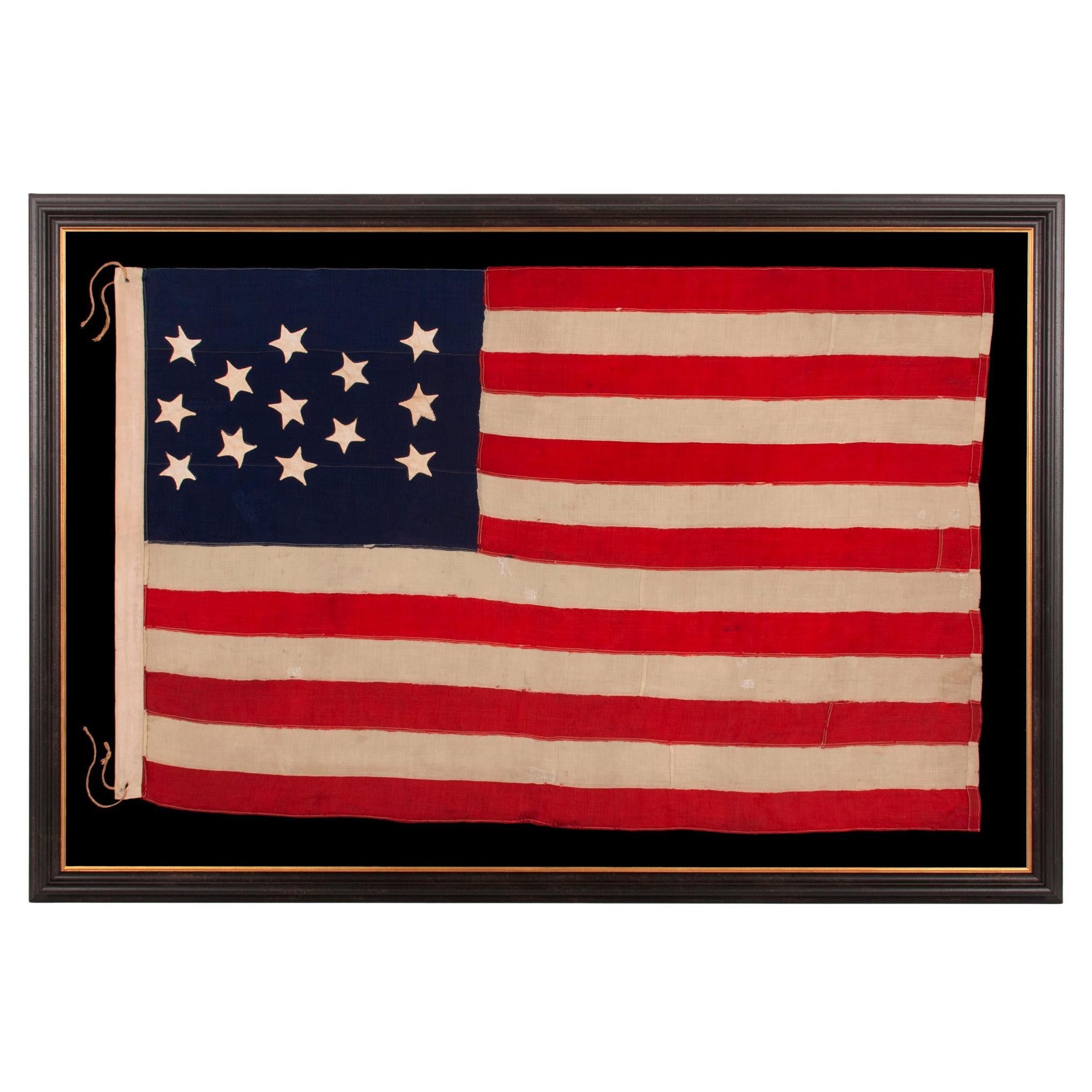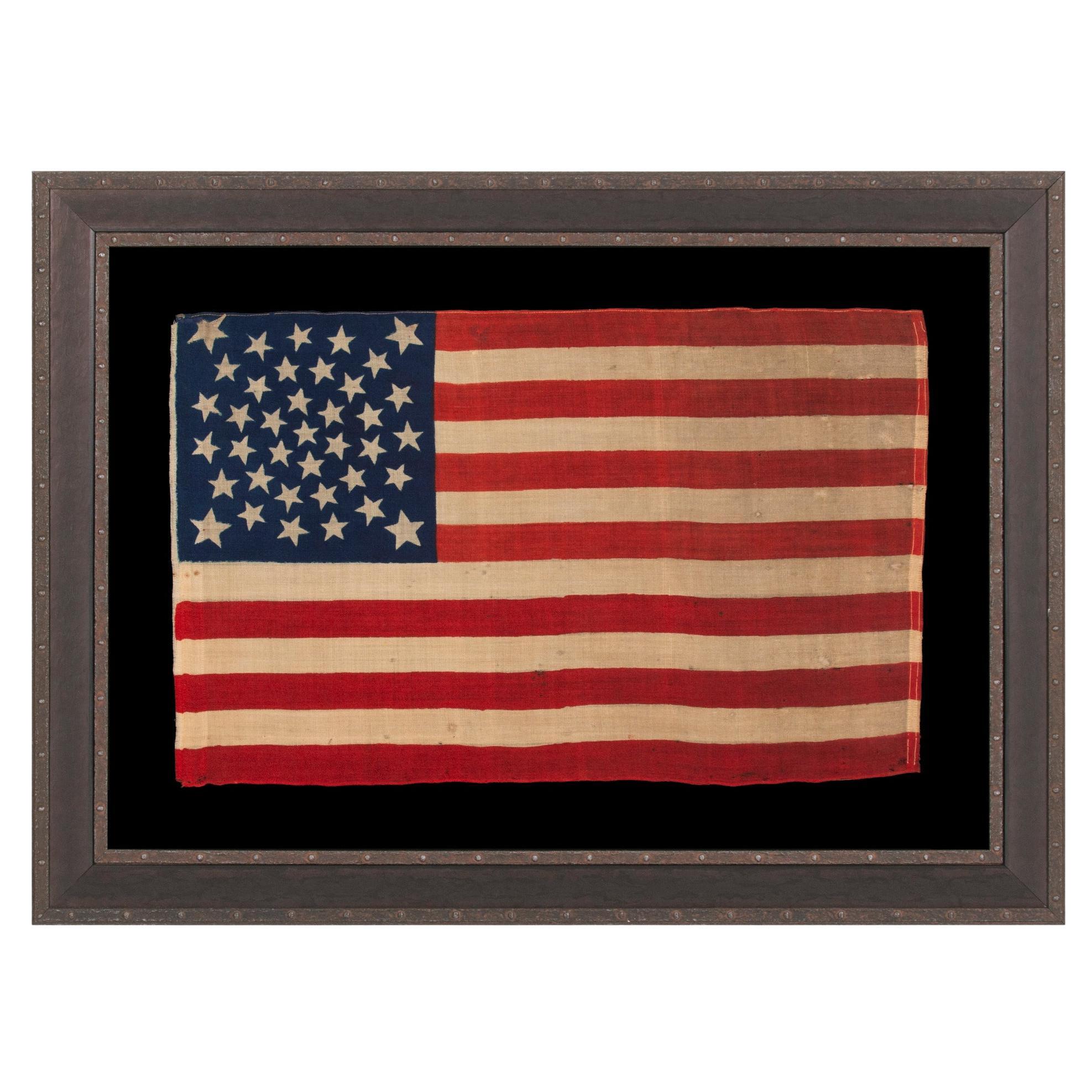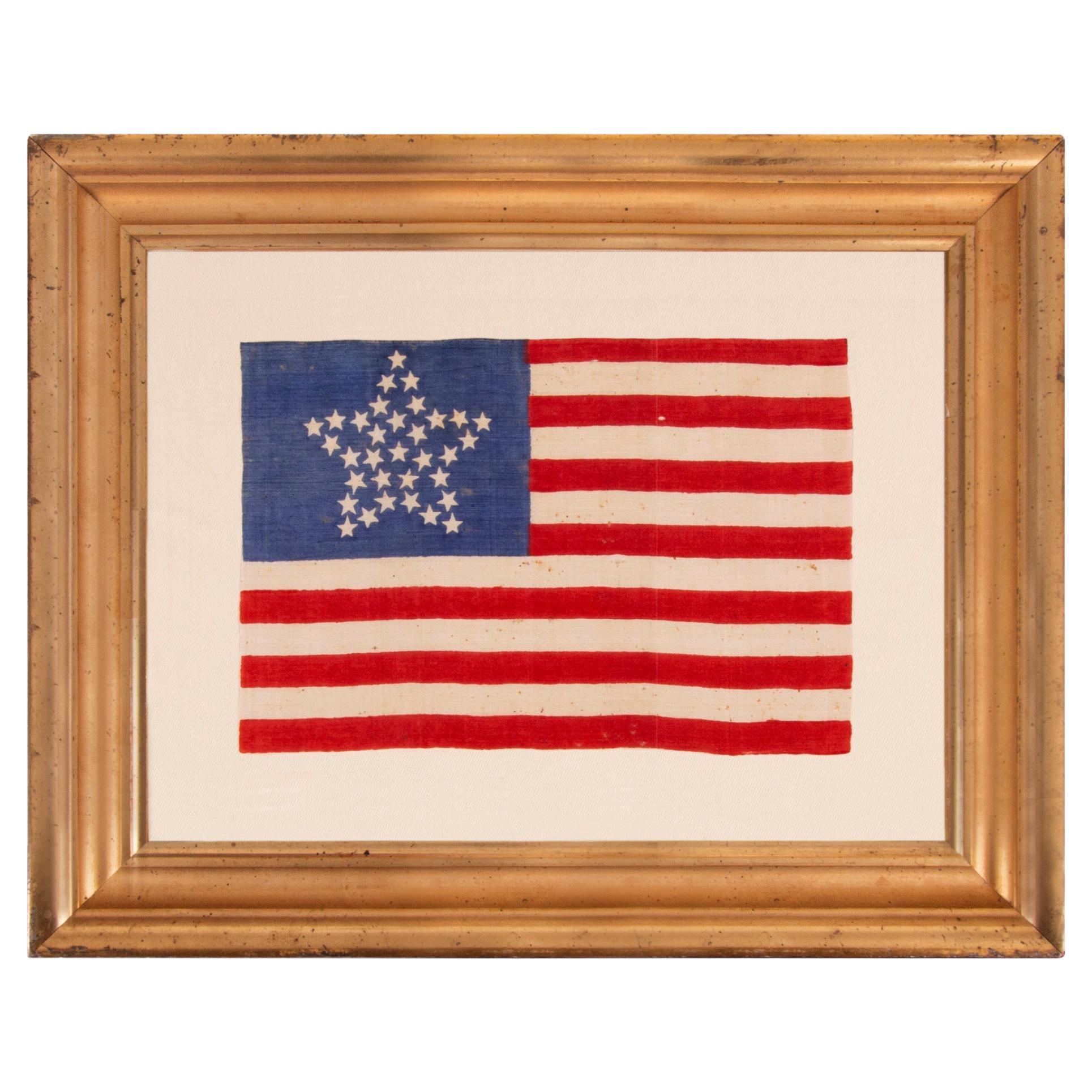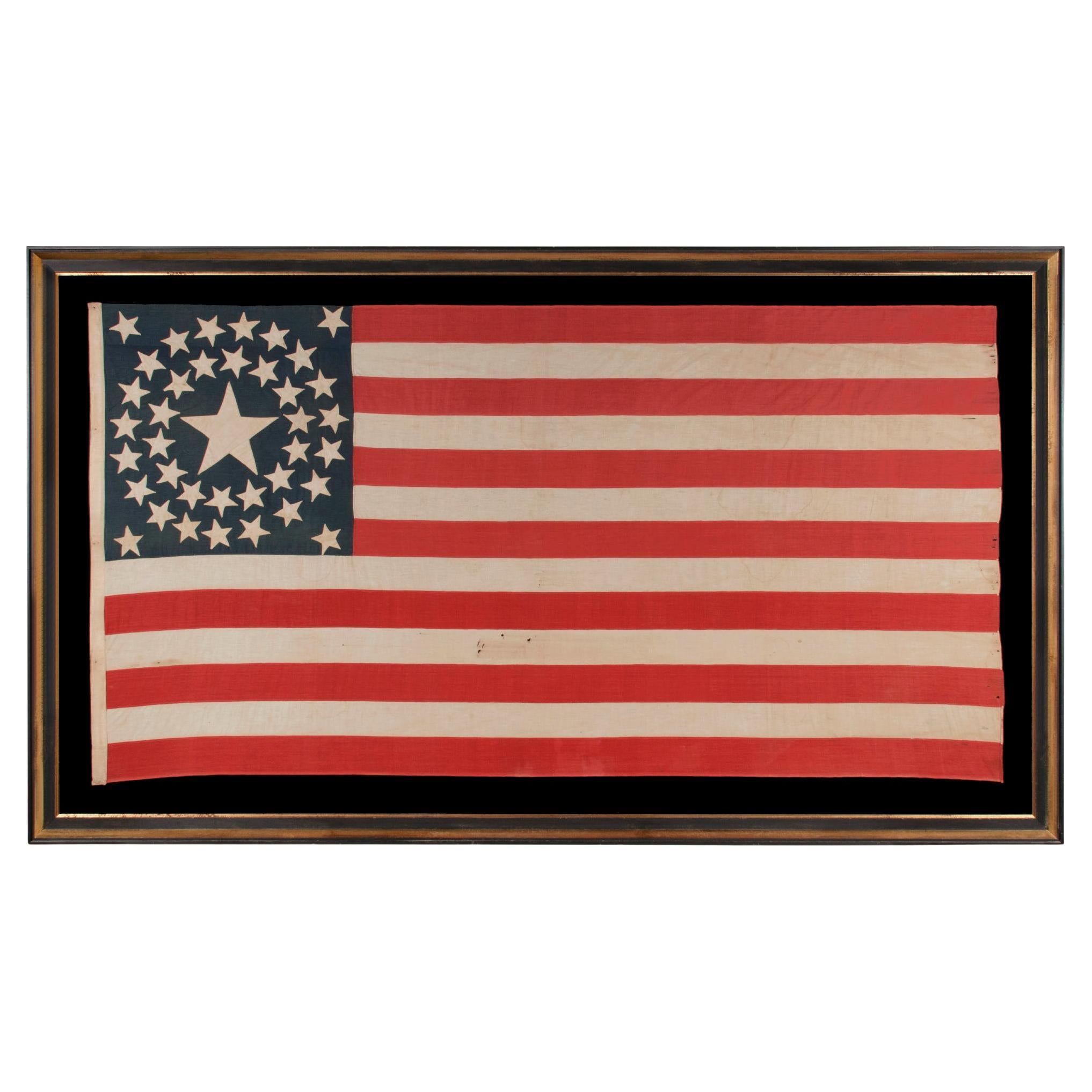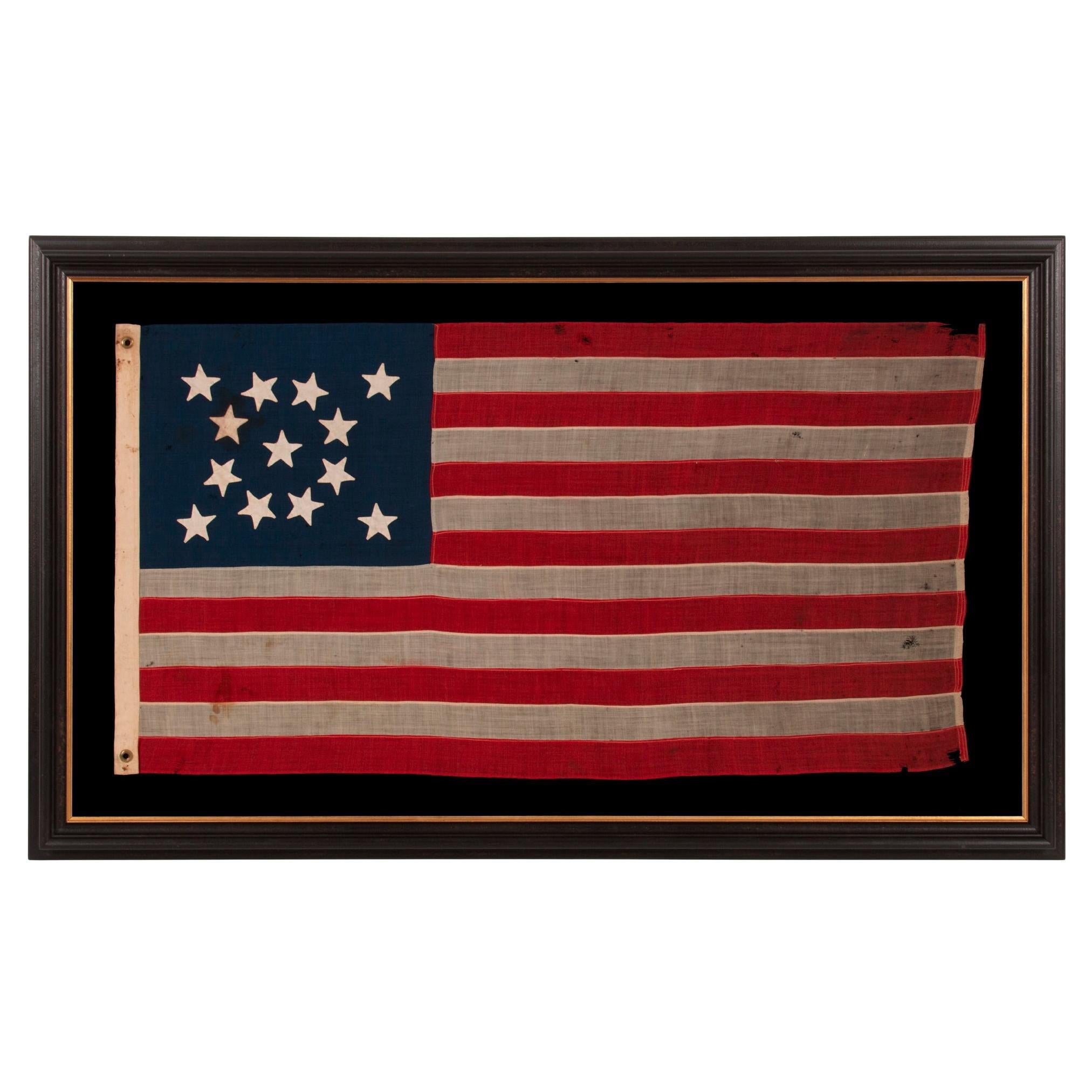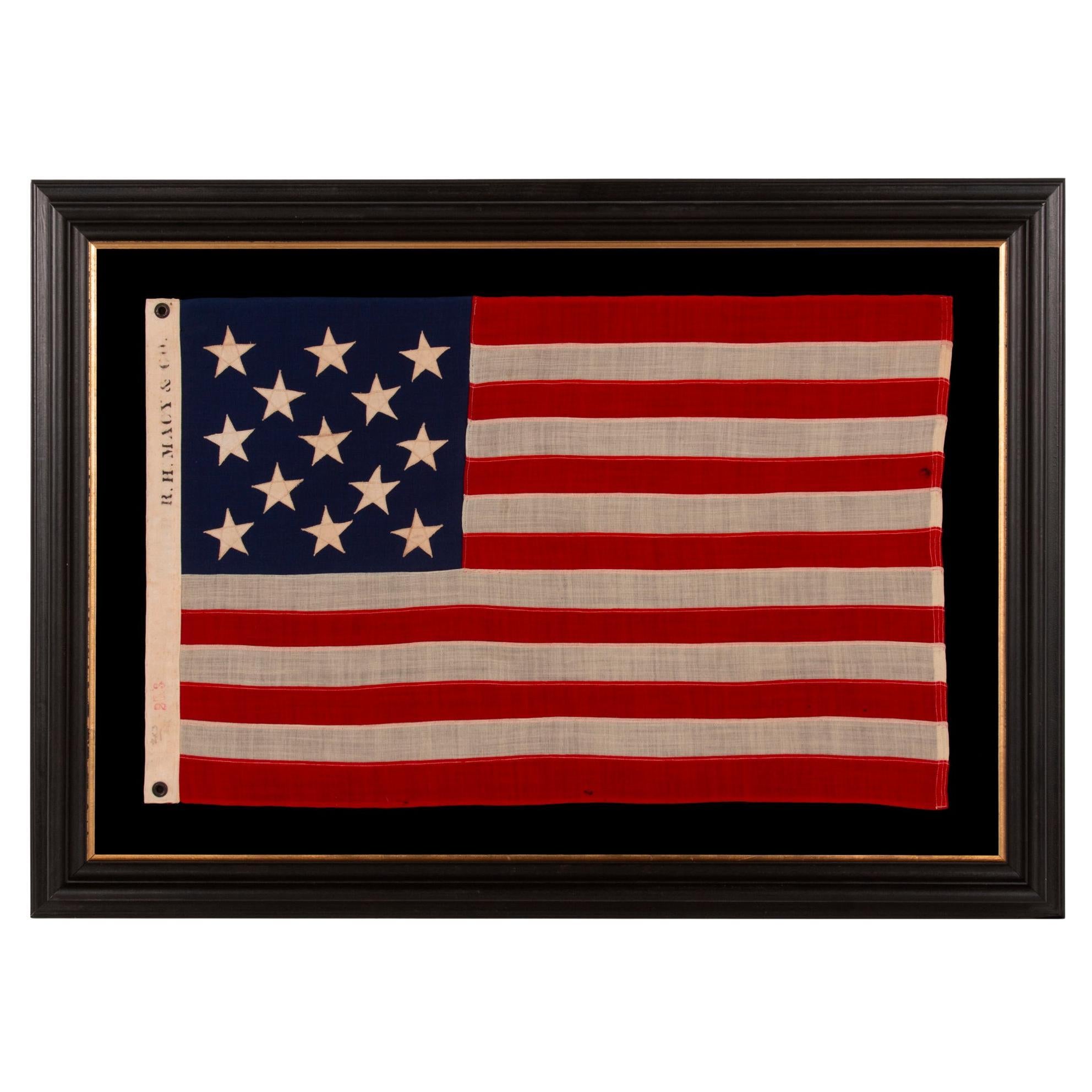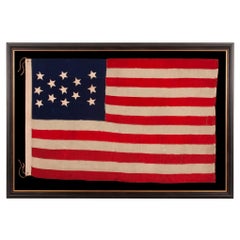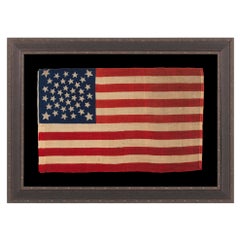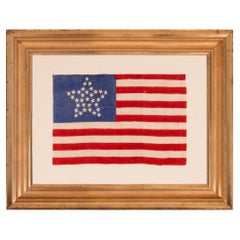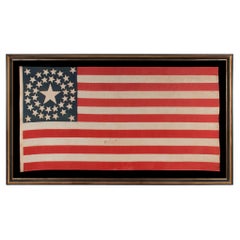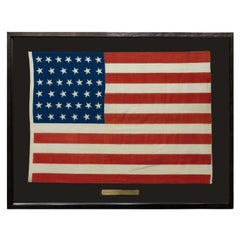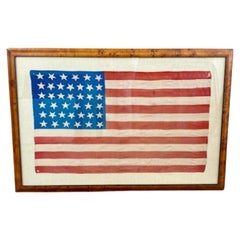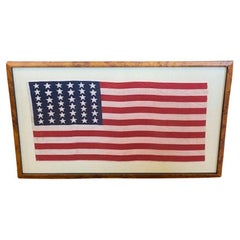Items Similar to 38 Star Rare Circle in A Square Horstmann Brothers Made American Flag, ca 1876
Want more images or videos?
Request additional images or videos from the seller
1 of 5
38 Star Rare Circle in A Square Horstmann Brothers Made American Flag, ca 1876
Price Upon Request
Price Upon Request
Price Upon Request
Price Upon Request
Price Upon Request
Price Upon Request
Price Upon Request
Price Upon Request
Price Upon Request
Price Upon Request
About the Item
38 STARS IN A RARE AND STRIKING CIRCLE-IN-A-SQUARE MEDALLION, WITH AN ENORMOUS CENTER STAR, MADE FOR THE 1876 CENTENNIAL CELEBRATION BY HORSTMANN BROTHERS OF PHILADELPHIA, A MAJOR MILITARY OUTFITTER
38 star American national parade flag, press-dyed on wool bunting, with an especially rare type of medallion star pattern that consists of a huge center star, surrounded by a wreath of stars, with a square of stars around the perimeter. This design is significantly more rare than the equally beautiful “great star” pattern (a star made out of stars), generally thought of as the Rolls Royce of configurations among 19th century designs. Circle-in-a-square patterns are so scarce that even major collectors like Boleslaw Mastai, who wrote the first major text on flag collecting and owned more than 600 flags and flag-related objects, was evidently never fortunate enough to acquire one.
Many fantastic star patterns were made in the patriotism that accompanied or nation’s 100-year anniversary of independence in 1876 and this is among the best of all examples. Note how the vertical alignment of the stars varies greatly, but that the center star, as well as the stars in the left and right columns, all have one point directed upright. There were no regulations concerning either star configuration or position until 1912, and many flag-makers went out of their way to catch the attention of potential buyers.
The flag was made by Horstmann Brothers, a major Civil War military outfitter. I have owned examples of this precise and extremely scarce variety, on which the Horstmann name was printed. Due to the fact that the company was located in Philadelphia, and that the Centennial International Exposition—our nation's first major World’s Fair, which served as the nucleus of the national celebration—took place in the same city, in 1876, it is logical to assume that Horstmann supplied these flags to be displayed there. Photos of them, actually in use at the Expo, survive from two locations, one in a fan of flags (3 displayed) emerging from a patriotic shield, just to the left of the pavilion of Philadelphia map and print publisher Augustus Mitchell, high up on post #Q78, in the Main Building, and another from within the display of the AM District Telegraph Company (2 displayed, precise location unknown).
Note the attractive, royal blue color of the canton. Most known Horstmann examples in this rare design have much darker coloration. Sometimes there is a formal binding along the hoist of this style of flag, and sometimes not. In this case, both the hoist and fly ends are simply hemmed with treadle stitching. A series of small tack holes along the hoist, with small, associated rust stains, demonstrates how it was affixed to a wooden staff, with metal tacks.
Press-dyed wool flags are scarcer than those printed on cotton and silk. Because parade flags were often intended for one day's use at a parade, political rally, a reunion of soldiers, or some other patriotic event, most were made of cotton. While cotton absorbs water, short-term use precluded the need for anything more hardy. Because the Centennial Exposition lasted for a period of six months, it required decorative flags that would sustain being flown for a longer time and withstand the elements. Because wool sheds water, it was the fabric of choice selected by flag-makers for extended outdoor use. Prior to this time, press-dyed wool flags primarily served military function. With the advent of lengthy World’s Fair events in America, they were well-suited for the long-term, decorative applications these required and adapted as such.
Colorado became the 38th state on August 1st, 1876. This was the year of our nation’s 100-year anniversary of independence. Per the Third Flag Act of 1818, stars were not officially added until the 4th of July following a state's addition. For this reason, 37 was the official star count for the American flag in 1876. Flag-making was a competitive venture, however, and few flag-makers would have continued to produce 37 star flags when their competitors were making 38’s. It is for this reason that 38 and 13 stars (to represent the original 13 colonies) are more often seen at the Centennial Expo.
Some flag-makers would have been adding a star for the 38th state even before it entered the Union, in the early part of 1876 or even prior. In fact, many makers of parade flags were actually producing 39 star flags, in hopeful anticipation of the addition of two more Western Territories instead of one. But the 39th state would not join the Union for another 13 years, when the Dakota Territory entered as two states on the same day. The 38 star flag became official on July 4th, 1877 and was generally used until the addition of the Dakotas in 1889.
A Brief History of the Horstmann Company:
William H. Horstmann (1785-1850) was the founder of what would become a major military outfitter in both Philadelphia and New York City. A solider and fourth generation passementier (textile weaver), Horstmann emigrated to the United States from Cassel, Germany in either 1815 or 1816, settling in the Germantown area of Philadelphia, where there was a significant concentration of textile manufacturing. Horstmann established a business of manufacturing fringe, laces, and trimmings at 50 N. Third St. and soon after married the daughter of Frederick Hoeckly, the most successful lace manufacturer in the city. In 1824 he introduced three significant tools to America, including the first jacquard loom, for weaving multicolored fabrics, the first braiding machine, and a machine for plating metal. Moving to the corner of 59th & Third, he imported technology from Germany and elsewhere and maintained regular trade with his family in Europe. The company grew exponentially in size and had many addresses over its years of operation
In 1828, the William H. Horstmann Military Store opened and in 1831 he established a New York branch. In 1843 the name was changed to the William H. Horstmann & Sons Military Store, and in 1859 it was taken over by sons Sigmund H. and William J., who operated the business as Horstmann Bros. & Co. in both New York and Philadelphia. Taking on investors in the interim, from 1845-1849 it operated in NYC as Horstmann Sons & Drucker, then Horstmann Sons & Allien. As an outfitter of Civil War regiments, the firm manufactured its own goods, including flags, swords, drums, insignia, and many other items, and subcontracted for the manufacture of these objects as well, depending on financial sensibility. There were other investors and partners along the way, such as William S. Hassall and George Evans, who broke off and became a significant competitor as “Hassall & Evans.” Brothers Sigmund & William Horstmann passed in 1870 and 1872, respectively.
In 1877, the New York branch changed its name to that of partner H.V. Allien. In 1893 the Philadelphia location changed its name to simply “Wm. H. Horstmann Co.,” operating as such until 1940. In 1927 “Horstmann Uniform Co.” was established as a separate entity, though it operated in a building within the large, Horstmann campus. In 1948, both the Philadelphia and New York branches filed for bankruptcy and closed.
Mounting: The flag was mounted and framed within our own conservation department, which is led by expert trained staff. We take great care in the mounting and preservation of flags and have framed thousands of examples.
The background is 100% cotton twill, black in color, that has been washed and treated for colorfastness. The mount was placed in a gilded molding of exceptional quality, with a traditional, American profile, to which a step-down profile, shadowbox depth molding, with a very dark brown finish, almost black, with reddish undertones and highlights, was added as a cap. The glazing is U.V. protective acrylic (Plexiglas). Feel free to contact us for more details.
Condition: In addition to the aforementioned tack holes and associated rust stains along the hoist, there is a tiny moth hole in the canton and a few in the striped field, accompanied by a couple of extremely minor stains. Overall exceptional for a wool flag of the period, with extremely strong color.
Frame Size (H x L): 30" x 39.75"
Flag Size (H x L): 19" x 28.75"
About the Seller
5.0
Recognized Seller
These prestigious sellers are industry leaders and represent the highest echelon for item quality and design.
Established in 1991
1stDibs seller since 2008
70 sales on 1stDibs
Typical response time: 1 to 2 days
- ShippingRetrieving quote...Shipping from: York County, PA
- Return Policy
Authenticity Guarantee
In the unlikely event there’s an issue with an item’s authenticity, contact us within 1 year for a full refund. DetailsMoney-Back Guarantee
If your item is not as described, is damaged in transit, or does not arrive, contact us within 7 days for a full refund. Details24-Hour Cancellation
You have a 24-hour grace period in which to reconsider your purchase, with no questions asked.Vetted Professional Sellers
Our world-class sellers must adhere to strict standards for service and quality, maintaining the integrity of our listings.Price-Match Guarantee
If you find that a seller listed the same item for a lower price elsewhere, we’ll match it.Trusted Global Delivery
Our best-in-class carrier network provides specialized shipping options worldwide, including custom delivery.More From This Seller
View All13 Star Antique American Flag with a Narrow Star Presentation, ca 1876
Located in York County, PA
13 STAR ANTIQUE AMERICAN FLAG WITH HAND-SEWN STARS IN AN EXTREMELY NARROW PRESENTATION OF A 3-2-3-2-3 ARRANGEMENT ON A CANTON THAT DOESN’T FOLLOW SUIT, LEAVING WIDE EXPANSES OF BLUE ...
Category
Antique 1870s American Political and Patriotic Memorabilia
Materials
Wool
Price Upon Request
38 Star American Flag, Colorado Statehood, Made by Horstmann Brothers ca 1876
Located in York County, PA
38 STARS, COLORADO STATEHOOD, A SCARCE AND BEAUTIFUL ANTIQUE AMERICAN FLAG WITH A MEDALLION PATTERN AND 4 LARGE CORNER STARS, PRESS-DYED ON WOOL BUNTING, MADE BY HORSTMANN BROTHERS I...
Category
Antique Late 19th Century American Political and Patriotic Memorabilia
Materials
Wool
33 Star Antique American Flag with a Great Star Configuration, ca 1859-1861
Located in York County, PA
33 STARS ANTIQUE AMERICAN FLAG WITH A "GREAT STAR" CONFIGURATION ON A BRILLIANT, INDIGO BLUE CANTON, A RARE AND EXTRAORDINARY EXAMPLE, PRE-CIVIL WAR THROUGH THE WAR'S OPENING YEAR, 1...
Category
Antique Late 19th Century American Political and Patriotic Memorabilia
Materials
Silk
38 Star Antique Flag, Stars in Double Wreath Pattern, Colorado Statehood 1876-89
Located in York County, PA
38 STAR ANTIQUE AMERICAN FLAG WITH A DOUBLE-WREATH CONFIGURATION THAT FEATURES AN ENORMOUS CENTER STAR, REFLECTS THE PERIOD OF COLORADO STATEHOOD, 1876-1889:
38 star American national flag, made entirely of plain weave cotton. The stars are arranged in a medallion configuration. This features an enormous center star, surrounded by two wreaths of much smaller stars, with a flanking star in each corner of the blue canton. The sort of disparity here, present in the scale of the large star, versus those around it, is both exceptionally unusual and graphically dynamic.
Colorado became the 38th state on August 1st, 1876. This was the year of our nation’s centennial. Per the Third Flag Act of 1818, stars were not officially added until the 4th of July following a state's addition. For this reason, 37 remained the official star count for the American flag until part way through the following year. Flag-making was a competitive venture, however, and few flag-makers would have continued to produce 37 star flags when their competitors were making 38’s. Many flag-makers added a 38th star before Colorado entered the Union, in the early part of 1876, or possibly even prior. In fact, many makers of printed flags, called parade flags or hand-wavers, were actually producing flags in the 39 star count, in hopeful anticipation of the addition of two more Western Territories instead of one.
It is for these reasons that 38, 39, and 13 stars, to representing the original 13 colonies, are most often seen on flags displayed at the Centennial International Exhibition. Hosted in Philadelphia, this enormous event was our nation’s first World’s Fair, lasted for a duration of six months, and served as the nucleus of celebrations held to honor America’s 100-year anniversary of independence. The 38 star flag became official on July 4th, 1877 and was generally used until the 39th state was added in November of 1889.
This is probably a homemade flag, though sewn by a very skilled hand, or possibly, by two different individuals. The stripes are pieced and sewn entirely by hand, with remarkable care and precision. The canton is constructed of two lengths of blue fabric, that have been joined with treadle stitching. This was joined to the striped field by hand. The stars are double-appliquéd (applied to both sides) with treadle stitching. There is a treadle-sewn, cotton binding along the hoist, with five, hand-sewn grommets.
It is extremely unusual to encounter this combination of sewing methods. Soon after the sewing machine was mass-marketed, in the mid-1850’s, flag-makers both public and private made good use of treadle machines, to join stripes, when constructing American flags. During the Civil War (1861-65), most stripes were treadle-sewn. Stars were another matter. Until the advent of electric machines...
Category
Antique Late 19th Century American Political and Patriotic Memorabilia
Materials
Cotton
13 Star Antique American Flag , Hand-Sewn Stars in a Medallion, 1876 Centennial
Located in York County, PA
13 STAR ANTIQUE AMERICAN FLAG WITH A MEDALLION CONFIGURATION OF HAND-SEWN STARS AND A BEAUTIFUL, ELONGATED PROFILE, MADE IN THE ERA OF THE 1876 CENTENNIAL OF AMERICAN INDEPENDENCE, I...
Category
Antique 1870s Political and Patriotic Memorabilia
Materials
Wool
13 Star Antique American Flag, Marked "R.H Macy & Co", circa 1895-1926
Located in York County, PA
13 STAR ANTIQUE AMERICAN FLAG WITH A 3-2-3-2-3 CONFIGURATION OF STARS; A SMALL-SCALE EXAMPLE, MADE IN THE 1895-1926 ERA, MARKED “R.H. MACY & CO.”
13 star antique American flag of th...
Category
Antique Late 19th Century American Political and Patriotic Memorabilia
Materials
Wool
Price Upon Request
You May Also Like
39-Star Antique American Flag with 'Whimsical' Star Pattern, 1889
Located in Colorado Springs, CO
This is a 39-star unofficial American flag, handmade and printed on cotton. The flag dates to 1889 and has a unique history, thanks to its rare star-count.
The flag’s canton is prin...
Category
Antique 1880s American Political and Patriotic Memorabilia
Materials
Cotton
19th Century American 39 Star Flag, circa 1889
Located in Nantucket, MA
19th Century American 39 Star Flag, circa 1889, a period printed silk parade flag with a wavy pattern of dancing stars. This was never an official flag of the United States but was m...
Category
Antique 1880s American Federal Political and Patriotic Memorabilia
Materials
Silk
19th Century 39 Star American Flag, circa 1889
Located in Nantucket, MA
19th Century 39 Star American Flag, circa 1889, a printed linen ensign with 39 stars arranged in a wavy star pattern, with stripes in a very unus...
Category
Antique 1880s American Federal Political and Patriotic Memorabilia
Materials
Linen
31-Star Printed American Flag, Celebrating California Statehood, Circa 1850
Located in Colorado Springs, CO
This is a rare 31-star medallion printed American flag, celebrating the addition of California to the Union. The flag is printed on silk and has a spectacular “Great Star” canton pat...
Category
Antique 1850s American Political and Patriotic Memorabilia
Materials
Silk
38-Star Antique American Flag with Unique Canton, circa 1876-1890
Located in Colorado Springs, CO
This is a striking 38-star American flag. The flag dates to 1876-1890, when Colorado (represented by the large star in the center of the flag’s canton) joined the Union as the 38th s...
Category
Antique Late 19th Century American Political and Patriotic Memorabilia
Materials
Muslin
39-Star Printed American Flag, Commemorating North Dakota Statehood, 1889-1890
Located in Colorado Springs, CO
This is a 39-star unofficial American flag, celebrating North Dakota statehood. The printed flag dates to 1889 and showcases a “whimsical” star pattern in the canton. The flag's cant...
Category
Antique 1880s American Political and Patriotic Memorabilia
Materials
Fabric
